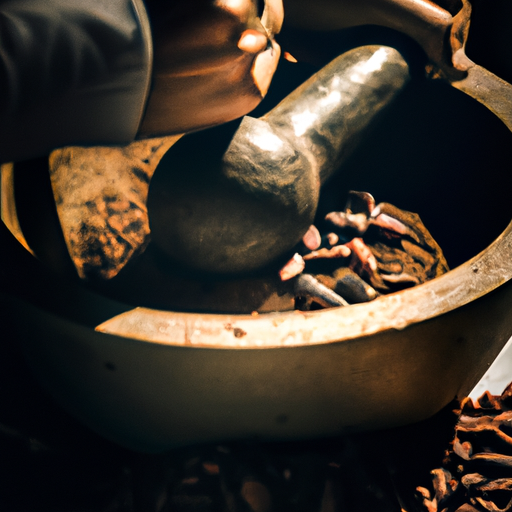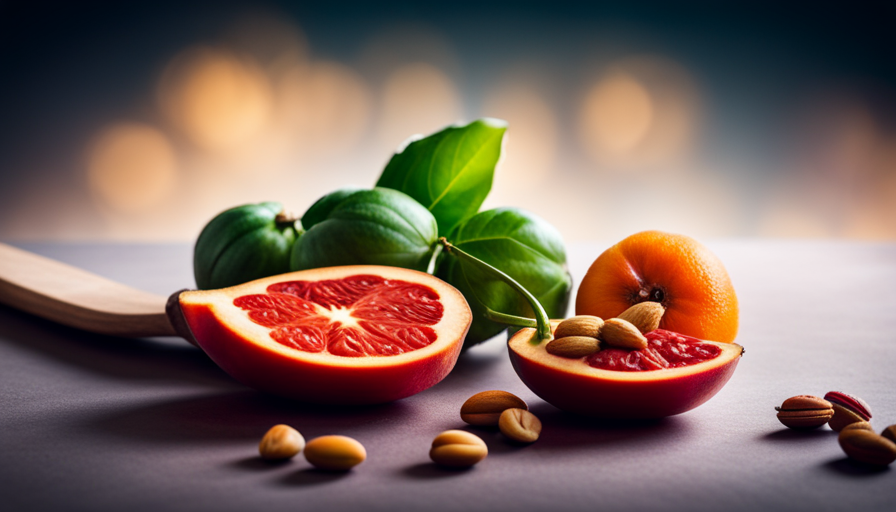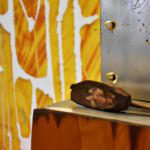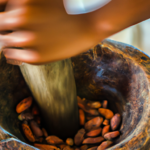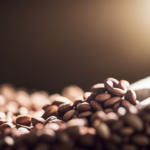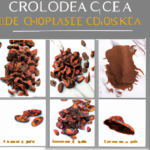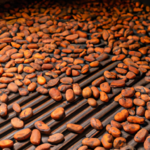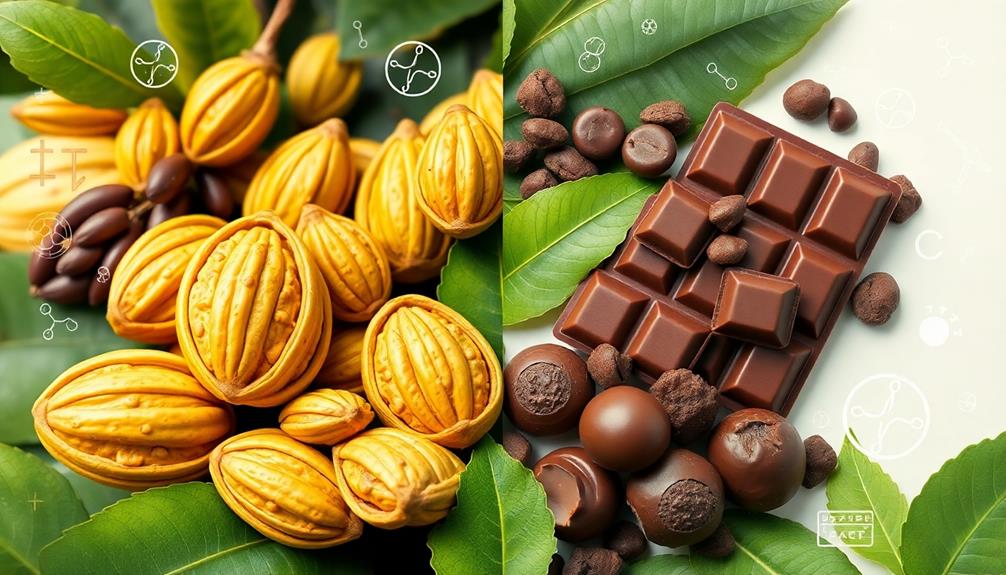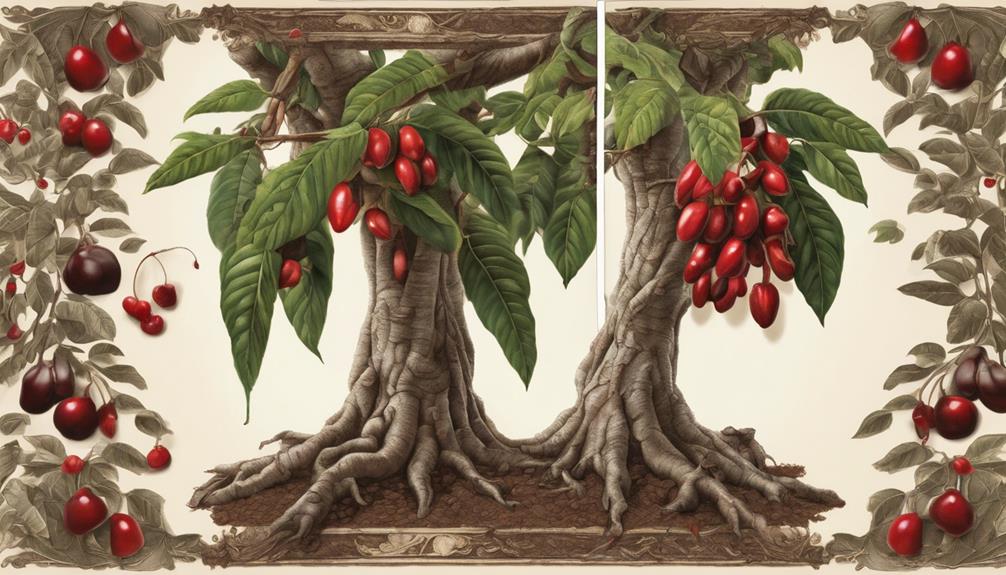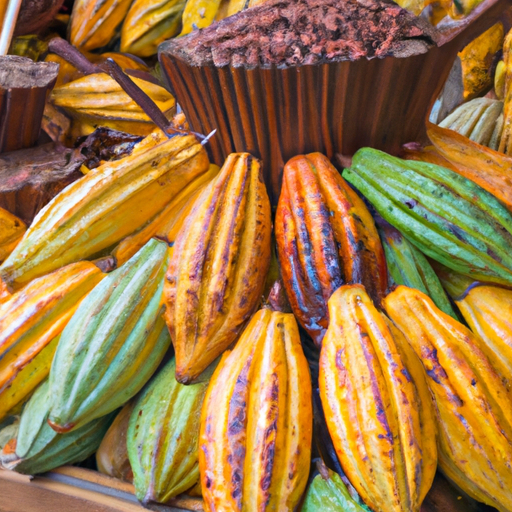I understand if you’re hesitant: creating homemade dark chocolate may seem daunting and time-consuming. However, rest assured, it’s simpler than you imagine. Additionally, the final product is a decadent delight that you can take pride in.
In this article, I’ll show you step-by-step how to make dark chocolate using raw cacao.
First, we’ll delve into the amazing health benefits of raw cacao and why it’s worth the effort to make your own chocolate.
Then, I’ll guide you through sourcing high-quality raw cacao beans and the process of roasting and grinding them to perfection.
We’ll also explore different sweeteners and flavorings to add that personal touch to your chocolate.
But we won’t stop there. I’ll teach you the art of tempering chocolate, ensuring a smooth and glossy finish.
We’ll discuss molding and cooling techniques, as well as proper storage to preserve your homemade dark chocolate.
Lastly, we’ll dive into the world of experimentation, exploring different variations and additions to take your chocolate-making skills to the next level.
So roll up your sleeves and get ready to indulge in the decadent world of homemade dark chocolate.
Key Takeaways
- Dark chocolate made from raw cacao is rich in antioxidants, magnesium, iron, and fiber.
- Sourcing high-quality raw cacao beans is important for ethical and sustainable reasons.
- Roasting methods of cacao beans affect the flavor of the dark chocolate.
- Tempering, molding, and proper storage techniques are essential for making and preserving homemade dark chocolate.
Understanding the Benefits of Raw Cacao
Now, you may be wondering why you should choose raw cacao over regular cocoa powder when making your own dark chocolate. Understanding the origins of raw cacao is key to appreciating its superior quality.
Raw cacao comes from the Theobroma cacao tree, which is native to the tropical regions of Central and South America. The beans are harvested, fermented, and dried to preserve their natural flavors and nutrients.
Exploring the health benefits of raw cacao reveals its rich antioxidant content, which can help reduce inflammation, improve heart health, and boost cognitive function. Additionally, raw cacao is a good source of magnesium, iron, and fiber.
Transitioning into the subsequent section about sourcing high-quality raw cacao beans, it’s important to ensure that you choose beans that have been ethically and sustainably sourced.
Sourcing High-Quality Raw Cacao Beans
To ensure you’re getting the best quality for your homemade treat, you’ll want to find the finest raw cacao beans available. When sourcing high-quality raw cacao beans, it’s important to consider sustainability practices and fair trade certifications.
Look for suppliers who prioritize sustainable farming methods, such as organic cultivation and biodiversity conservation. Additionally, seek out beans that are ethically sourced and support fair trade practices, ensuring that farmers receive fair compensation for their labor.
By choosing beans that adhere to these standards, you can contribute to a more sustainable and equitable cacao industry.
Now that we have obtained the highest quality beans, the next step is to roast and grind them to unlock their rich flavors and aromas.
Roasting and Grinding the Cacao Beans
Once you’ve acquired the finest cacao beans, it’s time to unleash their delectable flavors and enticing aromas through the art of roasting and grinding.
Roasting techniques play a crucial role in developing the complex flavors of dark chocolate. You can choose between two main methods: low and slow or high and fast. The low and slow approach involves roasting the cacao beans at a lower temperature for a longer duration, resulting in a milder flavor.
On the other hand, the high and fast method involves a quick roast at a higher temperature, producing a bolder and more robust taste.
After roasting, the next step is grinding the beans. This can be done using a specialized grinder or a food processor. The goal is to achieve a fine, smooth texture that will eventually melt in your mouth.
Now, let’s move on to adding sweeteners and flavorings to your dark chocolate, enhancing its richness and depth.
Adding Sweeteners and Flavorings to Your Dark Chocolate
After roasting and grinding the cacao beans, it’s time to infuse your delectable creation with sweeteners and flavorings, elevating its richness and depth. To enhance the sweetness of your dark chocolate, you can opt for various sweetener alternatives such as organic cane sugar, maple syrup, or even coconut sugar. These alternatives not only add sweetness but also impart distinct flavors to the chocolate. Additionally, natural flavorings like vanilla extract, sea salt, or even chili powder can be incorporated to create unique taste profiles. Experimenting with different combinations of sweeteners and flavorings will allow you to personalize your dark chocolate according to your preferences. Once you have perfected this step, you can move on to the subsequent section about tempering the chocolate for a smooth and glossy finish, ensuring a professional touch to your homemade treat.
Tempering the Chocolate for a Smooth and Glossy Finish
To achieve a smooth and glossy finish on your homemade dark chocolate, proper tempering is essential. Tempering involves heating and cooling the chocolate to achieve the perfect texture and prevent it from becoming dull and grainy.
To start, gently melt your chocolate over a double boiler, stirring constantly until it reaches around 115°F. Remove it from heat and cool it down by stirring vigorously until it reaches 80°F.
Finally, reheat the chocolate to about 88°F while stirring continuously. This method will help you achieve a stable crystal structure, resulting in a smooth, shiny finish.
If you encounter any common tempering issues, such as streaks or blooming, try adjusting the temperature or stirring more vigorously.
With your chocolate perfectly tempered, you’re now ready to move on to molding and cooling your homemade dark chocolate, creating delectable treats that will impress everyone.
Molding and Cooling Your Homemade Dark Chocolate
To mold and cool your homemade dark chocolate, start by pouring the tempered mixture into silicone molds, ensuring each cavity is filled to the brim. This will result in perfectly shaped and sized chocolates.
Cooling techniques play a crucial role in achieving the desired texture and appearance. You can choose between two methods: air cooling or refrigerator cooling.
Air cooling involves leaving the filled molds at room temperature until the chocolate hardens completely. This process can take several hours, depending on the temperature and humidity of your surroundings.
On the other hand, refrigerator cooling speeds up the process, taking only around 30 minutes to solidify the chocolates.
Once cooled, carefully remove the chocolates from the molds, and they are ready to be enjoyed or stored.
Transitioning to the subsequent section about storing and preserving your dark chocolate, it is important to consider the proper methods to maintain its freshness and flavor.
Storing and Preserving Your Dark Chocolate
Properly preserving your homemade dark chocolate is essential to ensure its longevity and maintain its rich and indulgent flavor. To achieve long term storage, there are several chocolate preservation techniques that can be employed.
Firstly, it is important to store your dark chocolate in a cool and dry place, away from direct sunlight and strong odors. This will help prevent the chocolate from melting or absorbing any unwanted flavors.
Additionally, wrapping the chocolate tightly in aluminum foil or placing it in an airtight container will protect it from moisture and air exposure, which can cause it to spoil.
Lastly, if you want to extend the shelf life of your dark chocolate, you can refrigerate or freeze it, although this may affect its texture slightly.
With these preservation techniques in mind, you can now move on to experimenting with different variations and additions to further enhance the flavor of your homemade dark chocolate.
Experimenting with Different Variations and Additions
Get creative with your homemade dark chocolate by trying out different variations and mix-ins to add a burst of flavor and texture. Here are some exciting flavor combinations you can experiment with:
-
Sea salt and caramel: Sprinkle a pinch of sea salt and swirl in some caramel sauce for a sweet and salty treat.
-
Raspberry and almond: Add freeze-dried raspberries and crushed almonds for a fruity and nutty combination.
-
Peppermint and coconut: Crush some peppermint candies and mix in shredded coconut for a refreshing and tropical twist.
-
Espresso and hazelnut: Stir in some finely ground espresso beans and chopped hazelnuts for a rich and aromatic flavor.
Not only do these variations add a delicious twist to your dark chocolate, but they also offer additional health benefits.
Now, let’s move on to the next section about sharing and enjoying your homemade dark chocolate.
Sharing and Enjoying Your Homemade Dark Chocolate
Indulge in the rich, velvety goodness of your homemade dark chocolate and discover the joy of sharing it with loved ones. When it comes to tasting preferences, everyone has their own unique palate. To cater to different preferences, consider experimenting with various flavor combinations such as sea salt, almonds, or even chili powder. This allows you to create a personalized experience for each person you share your chocolate with. Presentation is key when it comes to making your homemade dark chocolate even more delightful. To elevate the experience, try wrapping your chocolate in beautifully designed packaging or placing them in elegant boxes. Additionally, you can create a tasting menu that showcases the different variations and additions you have made. This not only adds a touch of sophistication but also allows your guests to fully appreciate the flavors and textures. So, go ahead and enjoy the process of sharing and savoring your homemade dark chocolate.
Frequently Asked Questions
Can I use regular cocoa powder instead of raw cacao powder?
No, regular cocoa powder cannot be used as a substitute for raw cacao powder when making homemade dark chocolate. Raw cacao powder offers unique health benefits and alternative sweeteners can be used instead.
How long does it take for the chocolate to cool and harden in the refrigerator?
The cooling time for chocolate to harden in the refrigerator varies based on the recipe and the temperature of the refrigerator. Generally, it takes around 1-2 hours for the chocolate to cool and fully harden.
Can I use alternative sweeteners like honey or maple syrup instead of sugar?
Yes, alternative sweeteners like honey or maple syrup can be used in place of sugar when making dark chocolate with raw cacao. This not only adds natural sweetness but also provides health benefits from the raw cacao.
How long can I store homemade dark chocolate before it goes bad?
Dark chocolate can be stored for up to 2 years if stored properly. To ensure its freshness, store it in a cool, dry place away from sunlight and strong odors. Signs of spoiled chocolate include a peculiar odor, discoloration, or a rancid taste.
Can I use a microwave to melt the chocolate instead of a double boiler?
Yes, you can use a microwave to melt chocolate as an alternative to a double boiler. Place the chocolate in a microwave-safe bowl and heat it in short intervals, stirring in between, until melted and smooth.
Can I Use Raw Cacao to Make Dark Chocolate?
Yes, making chocolate bars raw cacao is possible. Raw cacao has a rich, intense flavor that is perfect for dark chocolate. When combined with sweeteners and other ingredients, raw cacao can be used to create delicious homemade dark chocolate bars.
Conclusion
In conclusion, creating your own dark chocolate using raw cacao is a rewarding and delicious experience. By understanding the benefits of raw cacao and sourcing high-quality beans, you can ensure a rich and nutritious end product.
The process of roasting, grinding, and tempering the chocolate requires precision and attention to detail, but the end result is a smooth and glossy finish.
With endless possibilities for customization and experimentation, you can truly make your dark chocolate unique. So go ahead, indulge in the art of homemade chocolate-making and savor the sweet rewards.

